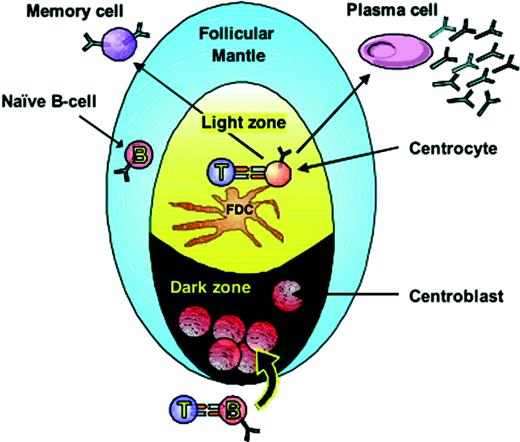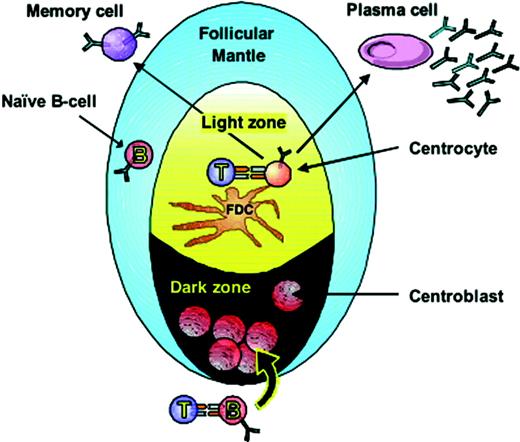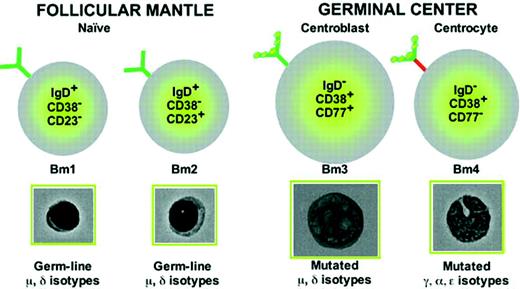THERE IS AN EMERGING consensus that, although death rates due to leukemias have dramatically fallen over the past 30 years, the opposite seems true for the non-Hodgkin’s lymphomas, particularly the B-cell lymphomas. With more than 35,000 cases per year in the United States, lymphomas take a substantial and increasing toll.
B-cell lymphomas arise from B lymphocytes. B-cell development can be conveniently divided into 2 phases: (1) an antigen-independent phase and (2) an antigen-dependent phase. The antigen-independent phase takes place almost exclusively in the bone marrow. During this time, B-cell precursors undergo a rearrangement of the V, D, and J gene segments and, under the influence of a myriad of enzymes, including terminal deoxynucleotidyl transferase (TdT) as well as exonucleases, the initial antibody repertoire is developed. Most acute B-cell leukemias involve cells in this phase of development. Obviously, tumors can be staged by the various cell surface phenotypes of the developing B cell. In addition, the B-cell receptor chains (heavy and light) can be assessed. In the most immature cells, no rearrangements have taken place, whereas in the later phase of this antigen-independent stage of development (before exit from the marrow), there has been complete VDJ rearrangement. Because the cells have not been exposed to antigen or to T cells in germinal centers, when the heavy and light chain genes are sequenced they display no somatic mutation (see Fig1).
Functional regions of peripheral lymphoid follicles. (Adapted from Liu and Banchereau.1)
Functional regions of peripheral lymphoid follicles. (Adapted from Liu and Banchereau.1)
Naive B cells leave the bone marrow and enter the peripheral blood as IgM+/IgD+ cells. Phenotypic analysis of mature human B cells has lagged considerably behind T cells. CD4 and CD8 ratios were in widespread use in a variety of clinical settings more than 2 decades ago. The mature human B lymphocyte has been particularly resistant to analysis, although its characterization with monoclonal antibodies to CD5, CD19, CD23, CD38, and CD77 is more and more common. Additionally, the characterization of Ig receptor isotype (IgM, G, D, A, and E) is in widespread clinical use. Nonetheless, there are few clinically relevant issues that require such characterizations.
Recent progress has been made in understanding the normal germinal center reaction, and from those studies, certain phenotypes of mature B cells seemed likely to be of clinical relevance. It is in the germinal center that the second or antigen-dependent stage of B-cell development takes place. Years ago now, we proposed (in collaboration with Virginia Pascual, Jacques Banchereau, and Yong Jun Liu) that IgD and CD38, in conjunction with CD23, CD77, and IgM, could be used to classify human mature B lymphocytes into 7 subsets.1-3 The most important conclusion of that work was that most IgD+CD38− normal tonsillar B cells were naive or virgin B cells. When we studied the VH gene sequences in these cells, they were unmutated. These and other studies demonstrated that these cells were located in the follicular mantle. On the other hand, the IgD−, CD38+ subset was extensively mutated (see Fig 2). Other studies showed that these cells were germinal center B cells (centroblasts and centrocytes). Finally, double negatives (IgD−, CD38−) represented the memory subpopulation. It was only logical that malignant counterparts for these normal cells existed.
The status of the immune receptor (Ig) genes in B-cell chronic lymphocytic leukemia (B-CLL) has long been a subject of controversy. Although some of the earliest studies demonstrated mutated VH genes in patients with clinically diagnosed CLL, several groups presented studies indicating that almost all patients with CLL had unmutated VH genes. Much of the confusion was the result of the fact that the human VHlocus had not been completely sequenced. Thanks to the heroic efforts of Matusda et al4 and Cook et al,5 we now have a complete picture of the human VH locus, thus eliminating much of the ambiguity of “it may be mutated, but then again, there may be other human germline genes.” The issue is not completely settled, because the extent of polymorphism at the human VHlocus is still not fully known, and more work is needed in this arena.6
Three distinct issues have been contentious for years. (1) Are the Ig variable region genes mutated or not in B-CLL? (2) Do any phenotypic markers correlate with prognosis? (3) Are particular Ig V genes used more than one would expect in B-CLL? There are several reports in the literature that come to contradictory conclusions on all three points. Two reports published in this issue of BLOOD address all 3 issues and largely put them to rest.7 8 Previous studies have attempted to correlate cytogenetic abnormalities with mutation and/or prognosis (many patients with B-CLL have trisomy 12, whereas many others have structural aberrations of 13q14). Recently, it has been demonstrated that approximately 30% of patients with B-CLL have interstitial deletions of the retinoblastoma gene. And very recently, a great deal of excitement has been generated by the report that greater than 80% of patients with B-CLL have somatic deletion of the BRCA 2 locus. However, in many respects, much of the difficulty that has been encountered with these kinds of clinical correlations, in our view, is the use of the CD5 marker for diagnosis and prognosis. In the vast majority of cases, B-CLL cells are CD5+. CD5 is a marker of fetal B lymphocytes in mice and is present in early B-cell differentiation in humans. Attempts to use CD5 as a marker for B-CLL have been fraught with the difficulty that as an activation marker, its expression is more complex than originally thought.
The work of Damle et al7 and Hamblin et al8clearly shows the potential clinical value of molecular characterization of the malignant clone in B-CLL. In most cases, the precursor cells from which tumors develop set the limits of the biological behavior of the tumor, due principally to the differentiation state of the precursor cell. It is intuitive that a less differentiated lymphocyte precursor should give rise to a subtype of CLL that has greater malignant potential and thus a poorer prognosis in general.
The maturation of B cells is reflected by the mutational state of the Igs they produce, ie, germline configuration early in development or mutated during affinity maturation. For some time we have been looking at diseases that correlate with such phenomena. These 2 groups of investigators have not only demonstrated and mutually corroborated that the mutational status of the Ig gene correlates with identifiable disease subsets, but they have also shown that this difference correlates with prognosis. Additionally, they have shown that B-CLL cases appear to arise from B cells of at least 2 distinct maturational stages.
Today, most clinical laboratories do not have the capacity to isolate and characterize Ig V gene sequences. However, with the finding that mutational status of the VH locus correlates with prognosis, it is likely that determination of the mutational status of Ig V genes will someday become routine. In the meantime, the finding by Damle et al7 that CD38 status correlates with Ig mutational status may well prove to be a practical finding that gives the mutational status of Igs in CLL patients significant clinical consequences today. When viewed in the perspective of normal B-cell development, this finding makes perfect sense (see Fig 2). However, caution should be exercised until the value of CD38 as an indirect marker for mutational status has been corroborated by other investigators.
This clinical finding may have implications for basic scientists as well. Because there apparently is a good correlation between this surface marker and maturation/mutational status of B cells, the potential role of the CD38 molecule in this change becomes an interesting question.
Human VH and VL gene analysis for hematological malignancies in the B-cell lineage has other advantages. In addition to determining whether the malignant cells have been through a germinal center reaction or not, sequencing not one but several clones from a patient at a single or a second visit allows the physician to determine if the mutational process is on-going. If so, the tumor is typically a Burkitt’s lymphoma, follicular cell lymphoma, or diffuse large-cell lymphoma rather than a B-CLL, myeloma, or mantle cell lymphoma.
Thus, Ig gene analysis can be reduced to the scheme shown in Table1.
Assuming that the finding that mutational status and prognosis with B-CLL withstands the scrutiny of additional study, future investigations could use this information to direct patients towards more or less aggressive forms of therapy. Thus, these findings may prevent the unnecessary use of chemotherapy in those patients with mutated V genes, thereby avoiding unnecessary toxicity and infectious complications of chemotherapy. This will be of immediate benefit to those using these markers. However, because the available therapy for CLL remains limited at present, it may be several years before these findings achieve their ultimate clinical consequences. For the immediate future, it is at least a big advance in terms of prognosis, irregardless of whether we have the therapeutic tools to convert this into a major therapeutic advance. It will now be up to astute clinicians to first confirm the usefulness of CD38 as a marker for Ig mutational status and then to take advantage of this knowledge to improve management of patients with CLL.
The finding that mutational status is related to tumor prognosis confirms what we have always believed: biologic behavior is ultimately linked to the molecular characteristics of a cell. This should spur future investigations to identify additional molecular markers that predict biologic behavior.
The publication costs of this article were defrayed in part by page charge payment. This article must therefore be hereby marked “advertisement” in accordance with 18 U.S.C. section 1734 solely to indicate this fact.
REFERENCES
Author notes
Address reprint requests to J. Donald Capra, MD, Oklahoma Medical Research Foundation, 825 NE 13th, Oklahoma City, OK 73104.





